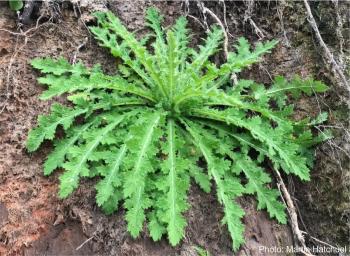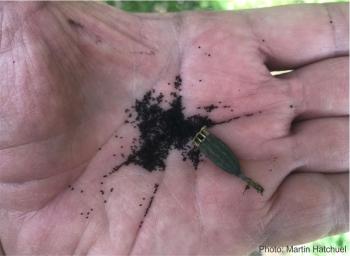Papaver aculeatum
Papaver aculeatum Thunb.
Family: Papaveraceae
Common names: bristle poppy, orange poppy (Eng.); doringpapawer, koringpapawer, wildepapawer (Afr.); sehlohlo (South Sotho)
Introduction
Papaver aculeatum is an attractive, orange- or pinkish-orange-flowered annual, and the only poppy endemic to the southern hemisphere. It makes an attractive addition to the rock garden, the front to middle of a border, and mixed container plantings.

Description
Description
This summer-growing annual has a taproot and reaches up to 1.8 m high in flower. It forms an erect, branched bush, with prickly stems and deeply divided, light green or grey-green, prickly leaves. It bears solitary, shallowly cup-shaped, orange or pinkish-orange blooms, along erect racemes, each flower carried on long, upright stalks, which are covered with stiff hairs that stick out more or less at right angles just below the flowers. Each flower comprises 4 broad petals with slightly wavy edges. The petals surround the prominent green ovary, and the numerous delicate, white filaments have bright yellow anthers, and arise in a circle around the ovary. The ripe fruit is a narrowly club-shaped capsule, producing masses of minute, brown, disc-shaped seeds. The chromosome number is 2n = 22. Flowering takes place from late spring to mid-autumn (October to late March).

Papaver aculeatum flowers are superficially similar to those of P. dubium, an introduced species from Europe, which differs in having reddish-orange petals, black filaments, and stiff hairs that lie flat against the upper part of the flower stalks just below the flowers.

Conservation Status
Status
According to the Red List of South African Plants website, Papaver aculeatum is assessed as Least Concern (LC), which indicates that it is considered at low risk of extinction, because of its widespread distribution.

Distribution and habitat
Distribution description
Papaver aculeatum occurs in all the provinces of South Africa, and is also found in Eswatini , Lesotho and Namibia. It is widespread and common in the colder, inland parts of South Africa, especially in the Eastern Cape interior, Free State and Gauteng. It is also recorded in eastern and south-eastern Australia, and on King Island and Flinders Island in Tasmania, where it is presumed to have been introduced from South Africa. It is common along disturbed road verges, in agricultural fields, in rocky habitats, among boulders in riverbeds, on hill slopes and cliffs, and on open flats among scrub, growing in a variety of media, including sand, loam, gravel and clay. It sometimes occurs at sea level, and inland forms can occur at an altitude of up to 2 950 m, and are hardy.

Derivation of name and historical aspects
History
The genus Papaver is derived from the Latin word pappa, meaning ‘milk’, because of the milky latex in its stems and leaves. The Latin specific name aculeatum, meaning ‘prickly’, refers to the prickly leaves and stems. The species was described by the Swedish naturalist Carl Peter Thunberg in volume 2 of his Prodromus plantarum capensium, in 1800. Papaver gariepinum Burch. ex DC and P. horridum DC are synonyms.
Papaver is a genus of about 100 species of annuals, biennials and perennials, and is one of about 42 genera and more than 700 species in the horticulturally and economically important family, Papaveraceae. Members of the genus Papaver are popular garden plants, such as the common poppy (P. rhoeas), Iceland poppy (P. nudicaule), oriental poppy (P. orientale) and opium poppy (P. somniferum). The opium poppy, also known as the breadseed poppy, is also widely grown as an agricultural crop for its seeds, for human consumption (poppy seeds), and to produce opium and drugs, like morphine and codeine, for medicinal purposes, in the pharmaceutical industry.

Ecology
Ecology
Papaver aculeatum is a short-lived, summer-growing annual. The seeds germinate in spring. Individual flowers are short-lived, lasting only a few days. They open in bright sunshine but remain closed in cloudy or rainy weather. The flowers are pollinated mainly by honey bees. After fertilization, capsules form rapidly, and as soon as they become dry, the seeds are dispersed through a circle of narrow openings near the top of the capsule, just below the dried stigmas. Dispersal takes place by the shaking action of wind (anemochory), the seeds falling out when the wind shakes the dried stalks strongly enough. The dispersed seeds remain dormant for several months, and germinate when the rainy season starts.
Uses
Use
Papaver aculeatum has no magical or medicinal uses, but the Sotho people use the leaves of young plants as a herb, in cooking, however, mature plants are toxic and are, therefore, avoided. It is sometimes used by gardeners as an ornamental annual.

Growing Papaver aculeatum
Grow
Papaver aculeatum is an easily grown plant for rock garden pockets, front borders, or as a subject for mixed plantings in containers, such as window boxes and patio pots, grown with Lobelia valida, for example. It is also suitable for meadow plantings, mixed with grasses, like Melinis repens (Natal red top), and bulbous plants, like Watsonia pillansii. The plants require full sun and well-drained soil containing some compost. Sow the seeds in seed trays spring. Cover the seeds lightly and place in a warm, protected place. Alternatively, scatter the seeds directly onto the soil in rock garden pockets, beds and containers, and cover lightly. Water well with a watering can, and keep moist by watering every second day, in the absence of rainfall. Germination takes place within 2 weeks, and seedlings can be pricked out after several weeks, or once large enough to handle. Keep well-watered for the first week after planting. Once established, the plants are remarkably waterwise, and thereafter, they seed themselves quite freely from year to year. The plants are pest- and disease-free.
References
- Hallé, J. 2022. Observation of Papaver aculeatum, KwaZulu-Natal Drakensberg. iNaturalist. Online. https://www.inaturalist.org/observations/110738721.
- Hatchuel, M. 2018. Observation of Papaver aculeatum, Knysna, Eastern Cape. iNaturalist. Online. https://www.inaturalist.org/observations/23110246.
- Kadereit, J.W. 1988. The affinities of the south-hemispherical Papaver aculeatum Thunb. (Papaveraceae). Botanische Jahrbücher fur Systematik 109: 335–341.
- Maliehe, E.B. 1997. Medicinal Plants and Herbs of Lesotho. Mafeteng Development project, Lesotho.
- Pooley, E. 1998. A field guide to wild flowers Kwazulu-Natal and the eastern region. Natal Flora Publications Trust, Durban.
- Pooley, E. 2003. Mountain flowers, a field guide to the flora of the Drakensberg and Lesotho. Natal Flora Publications Trust, Durban.
- Roger Oliver, personal communication.
- SAplants, Wikimedia Commons, CC-BY-SA 4.0. https://commons.wikimedia.org/wiki/Category:Photographs_by_SAplants.
Credits
Graham Duncan
Kirstenbosch National Botanical Garden
July 2019, amended July 2022
Acknowledgements: additional images by SAplants, Martin Hatchuel and James Hallé.
Plant Attributes:
Plant Type: Bi/Annual
SA Distribution: Eastern Cape, Free State, Gauteng, KwaZulu-Natal, Limpopo, Mpumalanga, North West, Northern Cape, Western Cape
Soil type: Sandy, Clay, Loam
Flowering season: Spring, Early Summer, Late Summer, Autumn
PH: Acid, Alkaline, Neutral
Flower colour: Pink, Orange
Aspect: Full Sun
Gardening skill: Easy
Special Features:
Horticultural zones











Rate this article
Article well written and informative
Rate this plant
Is this an interesting plant?
Login to add your Comment
Back to topNot registered yet? Click here to register.